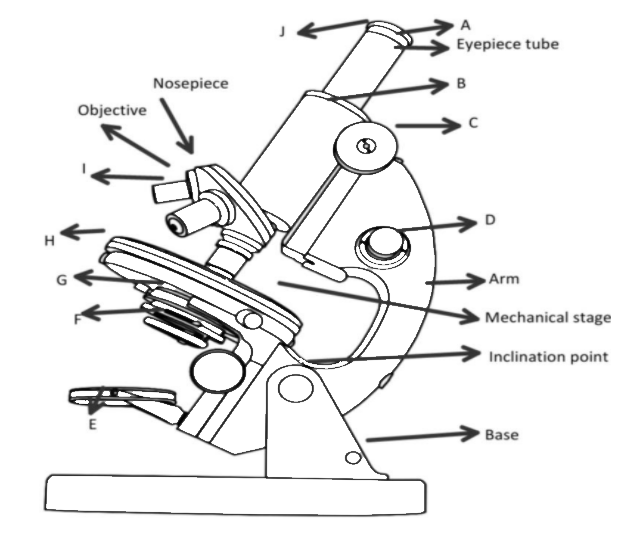
This is a common compound microscope. Label its parts from A to J.
1. Eyepiece removed
2. Iris diaphragm
3. Stage plate
4. Eyepiece
5. Mirror
6. Objective lens removed
7. Condenser
8. Microscope tube
9. Coarse adjustment knob
10. Fine adjustment knob


Answer
456k+ views
Hint: An instrument that is utilized for magnifying the image of those objects which we cannot watch by our naked eyes. The microscope shown in the image is a compound microscope. Compound Microscope utilized in forensic labs for students and scientists, for working on bacteria by bacteriologists and biologists, utilized for solving crime etc.
Complete answer:
The parts of the compound microscope from A to J and their functions are given below:
A. Eyepiece lens: It is used for magnifying the image.
B. Microscope tube: It separates the objective lens and eyepiece.
C. Coarse adjustment knob: It is used for the rough focusing of specimens.
D. Fine adjustment knob: It is used for the precise focusing of the specimen.
E. Mirror or light source: It is used for supplying light to the object.
F. Condenser: It is used to gather and focus light on the object or may not be present in all the microscopes.
G. Iris Diaphragm: It is used to control the amount of light reaching the object.
H. Stage plate: It is used for holding the slide, which contains the object.
I. Objective lens: It is used for magnifying the image.
J. Eye lens removed: This portion is referred to as when the eye lens is removed.
Note: A major significant part of a compound microscope is the objective lens. Because this lens is nearer to the specimen. Be careful, while focusing the microscope because the slide could break and destroy the specimen if the objective lens touches the slide. A standard microscope may have 3, 4, and 5 objective lenses.
Complete answer:
The parts of the compound microscope from A to J and their functions are given below:
A. Eyepiece lens: It is used for magnifying the image.
B. Microscope tube: It separates the objective lens and eyepiece.
C. Coarse adjustment knob: It is used for the rough focusing of specimens.
D. Fine adjustment knob: It is used for the precise focusing of the specimen.
E. Mirror or light source: It is used for supplying light to the object.
F. Condenser: It is used to gather and focus light on the object or may not be present in all the microscopes.
G. Iris Diaphragm: It is used to control the amount of light reaching the object.
H. Stage plate: It is used for holding the slide, which contains the object.
I. Objective lens: It is used for magnifying the image.
J. Eye lens removed: This portion is referred to as when the eye lens is removed.
Note: A major significant part of a compound microscope is the objective lens. Because this lens is nearer to the specimen. Be careful, while focusing the microscope because the slide could break and destroy the specimen if the objective lens touches the slide. A standard microscope may have 3, 4, and 5 objective lenses.
Recently Updated Pages
Master Class 9 General Knowledge: Engaging Questions & Answers for Success

Master Class 9 English: Engaging Questions & Answers for Success

Master Class 9 Science: Engaging Questions & Answers for Success

Master Class 9 Social Science: Engaging Questions & Answers for Success

Master Class 9 Maths: Engaging Questions & Answers for Success

Class 9 Question and Answer - Your Ultimate Solutions Guide

Trending doubts
State and prove Bernoullis theorem class 11 physics CBSE

What are Quantum numbers Explain the quantum number class 11 chemistry CBSE

Who built the Grand Trunk Road AChandragupta Maurya class 11 social science CBSE

1 ton equals to A 100 kg B 1000 kg C 10 kg D 10000 class 11 physics CBSE

State the laws of reflection of light

One Metric ton is equal to kg A 10000 B 1000 C 100 class 11 physics CBSE




